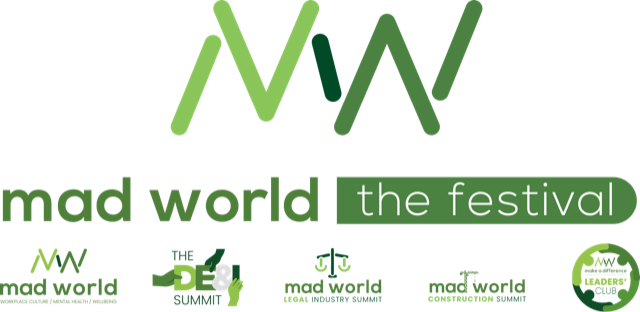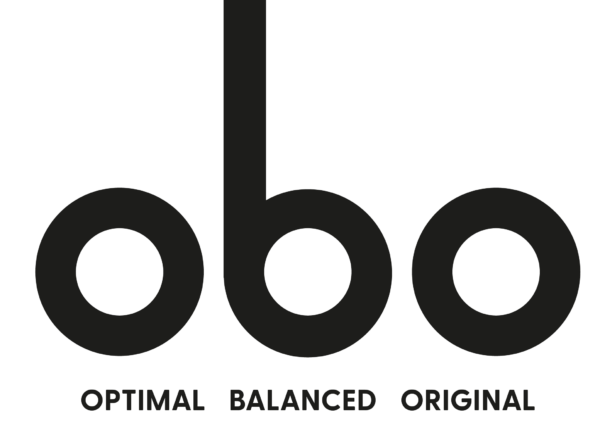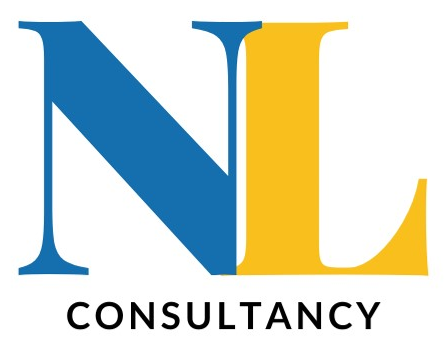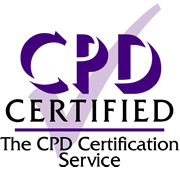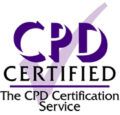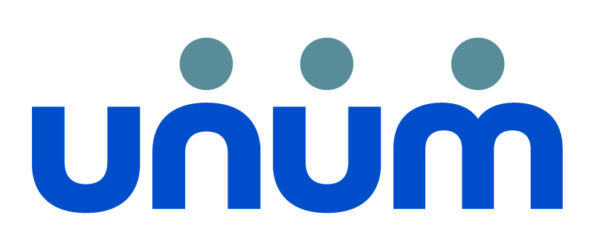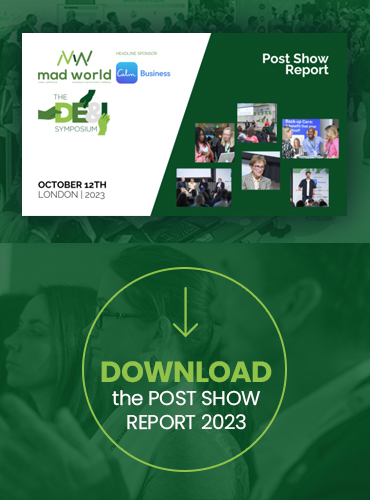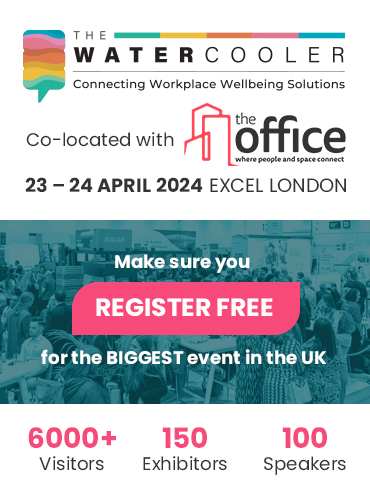The 6th annual MAD World Summit
After months of eager anticipation, the annual MAD World Summit came to life in person on October 12th in the heart of Central London. The event was a resounding success, with 970 attendees exploring inclusive workplace culture, mental health, and wellbeing content and solutions. With a diverse array of over 140 speakers, the summit proved to be a remarkable meeting of cross-sector employers in pursuit of insights and inspiration.
The MAD World Summit, renowned for its thought leadership in mental health and diversity, delivered a truly memorable experience this year. Attendees from various sectors came together to engage in conversations, share knowledge, and find solutions that promote a more inclusive and mentally healthy workplace.
One of the standout features of this year’s event was the inauguration of the Diversity, Equity, and Inclusion (DE&I) Summit. This addition emphasised the growing significance of DE&I in today’s workplace landscape and provided a dedicated space for exploring the synergies between mental health, diversity, and workplace culture.
The MAD World Summit 2023 was a celebration of insights, inspiration, and collaboration, and it set the stage for positive change in the realm of employee mental health & wellbeing, diversity, and workplace culture. It’s an event that will leave a lasting impact on the way organisations approach these vital topics. 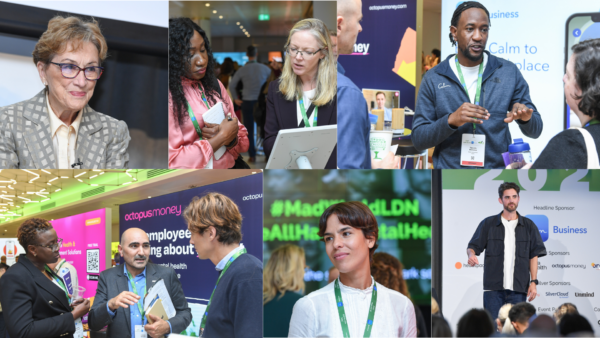
Key topics to be discussed:
- What you need to know to invest wisely in workplace wellbeing
- Wellbeing washing: – what it is, why it matters and how to overcome it
- The future of work through the lens of workplace culture, mental health and wellbeing
- Meeting the wellbeing needs of different working demographics in a hybrid world of work
- Safeguarding the health of the nation – getting people back to work effectively
- Creating a leadership playbook for a mentally-well organisation
- Measurement of workplace wellbeing – using data to elevate your strategy
Next year, the MAD World Summit will take place on October 17th, 2024. If you are interested in participating.
We'll Be Sharing
Latest Make A Difference News

A brief dive into Gen Z’s workplace satisfaction, and how it connects with younger people’s declining mental health.
The latest generation to enter the workplace is Gen Z, and they are often given a hard time. Considering they haven’t lived through the same “hardships” that previous generations have, and with the world being more comfortable than ever…why is there so much cause for them to complain? There is now even a trend of HR departments favouring older hires over younger counterparts. From Nordic employee wellbeing platform Kara Connect, Tobba Vigfusdottir shares her thoughts on why this generation might be struggling, and how employers can better navigate this new and largely misunderstood section of the workforce.
What is the problem?
People in their 20s are statistically more likely to be off work with ill health than employees in their early 40s. This trend has developed for several reasons, but it predominantly comes down to Gen Z being more likely to struggle with mental health issues. This, in part, is due to having grown up with social media; studies indicate that engagement with social media leads to higher rates of depression, self-harm and suicide. This worrying trend has developed to such an extent that, as reported by the Guardian, UK ministers were just last week discussing banning the sale of mobile phones to children under 16.
As digital natives, Gen Z are also equipped with the ability to navigate a vast sea of news and information; crucially including insights into equality and workplace conditions. Unlike prior generations, who often adhered to a “grin and bear it” mentality, Gen Z recognises that these approaches no longer make for a comfortable existence. They understand the toll that excessive work can take on their long term health, and are unwilling to compromise their wellbeing for the sake of an entry-level position unless the potential career trajectory is clear. Prioritising their health, many Gen Zers may not necessarily aspire to claim C-suite roles. Besides the career aims, the fact also remains that access to adequate healthcare and mental health support remains a luxury. It is beyond the reach of many young people due to financial constraints and extensive waiting lists within public healthcare systems.
These problems are often compounded by the response the wider world greets them with. Trivialising Gen Z’s habits and labelling them as “unable to cope with work” disregards the significant societal and economic factors that affect these employees. For example, navigating the move from education to employment whilst trying to keep on top of financial pressures, expectations of success, and higher rates of mental illness.
The challenges facing young professionals
The problems around Gen Z’s mental health stem, unsurprisingly, from a variety of factors. As mentioned, the rise of social media has had a profound impact, affecting young women more than men. They are exposed to more and more of the same sensational, perfected material. This idea of curated realities and constant connectivity leads to heightened stress levels, and potentially impacting brain development. This phenomenon is evidenced by the aforementioned alarming increases in suicide rates and depression.
People in general suffering with mental health may consequently also find themselves unemployed or in low-paid jobs. Having been exposed to social media their whole lives, resulting mental health issues often hinder Gen Z’s educational aspirations – whether by affecting concentration, attendance or academic performance. This ultimately limits job prospects. Then, for those who have begun their career, managing workplace stress and maintaining performance can be challenging even when in jobs. This leads to its difficulties, for example in securing advancement opportunities. Despite efforts to reduce stigma, discrimination persists in many workplaces against those who struggle with their mental health.
Strategies for employers
A big caveat for employers is that misunderstood and exploited workers no longer accept being taken advantage of. This generation expects to be treated with more respect. Psychologists are also seeing a great rise in Gen Z having a lower locus of control. This means that they don’t believe that they can impact their own futures, and are more likely to think that outside factors determine their fate – this could be luck, people in higher positions, or their academic success or failure. These factors together have led to a rise in silent quitting, where employees leave the workplace without even telling their line manager. This happens because they either don’t think it makes a difference, or because they are uncomfortable to approach their supervisors.
Luckily, there are workplace leaders who engage with any discrimination, and seek to push back against this phenomenon and how employees are treated. Here, I outline some of the many ways in which managers, HRs, and bosses can help to support Gen Z – and it is often as simple as recognising the root of the problem and showing understanding.
Creating a culture of awareness and support is essential. One can establish wellbeing support systems, or promote empathy amongst colleagues, but opening discussions about emotion and coping strategies can help build trust. Equally valid, of course, are those people who don’t immediately feel comfortable being part of something public.
Comprehending Gen Z’s mindset is key. Employers should recognise the myriad concerns that young people have. This includes, but is not limited to: job security, professional advancement, as well as transparent lines of communication around pay equity and PTO. Different communication styles are needed in companies hiring Gen Z – it is essential for success, both for them and the company, that grievances are aired and workers can explain what is bothering them. Also, it is important to remember that people who are anxious or dealing with mental health problems work better if they are told clearly about the job, benefits and where it can lead. They are not even afraid to ask “what is a job” – and are not looking for the location, or time in the office or at their desk – they want to know what is expected of them, and employers need to be able to explain.
I have already alluded to Gen Z’s wider education and digital proficiency. Employers should adapt to their preferences by implementing up-to-date tools and messaging platforms. This approach, as well as enhancing efficiency, also demonstrates a commitment to meeting Gen Z’s preferences. Beyond this, employers can go further and actively involve Gen Z in digital transformations. This gives employees confidence; their unique qualities can actively contribute to the work environment.
The bottom line is that while some corners of the media seem to feel obliged to peddle out the rhetoric that Gen Z’s workplace problems are overplayed, I’d like to emphasise that there has never been a more important time to prioritise mental health and wellbeing in the workplace. There are wonderful (and successful) initiatives in Nordic countries, aimed at achieving a better work-life balance. The bigger the reach of projects like these, the better. By strategising like this, employers will reap the benefit of supporting their employees, who in turn will be in a better position to support them.
About the author
Tobba Vigfusdottir is CEO at Kara Connect. Tobba holds an M.Ed in Educational Psychology from the University of Washington in Seattle, USA and a B.Ed. from the University of Iceland, She has worked as a political advisor to the Minister of Education and a project manager at the University of Reykjavík. Tobba is the Vice-Chairman of the National Theatre of Iceland and has sat on numerous public boards, including the Reykjavík Energy Company and Bus.is.
You might also like:
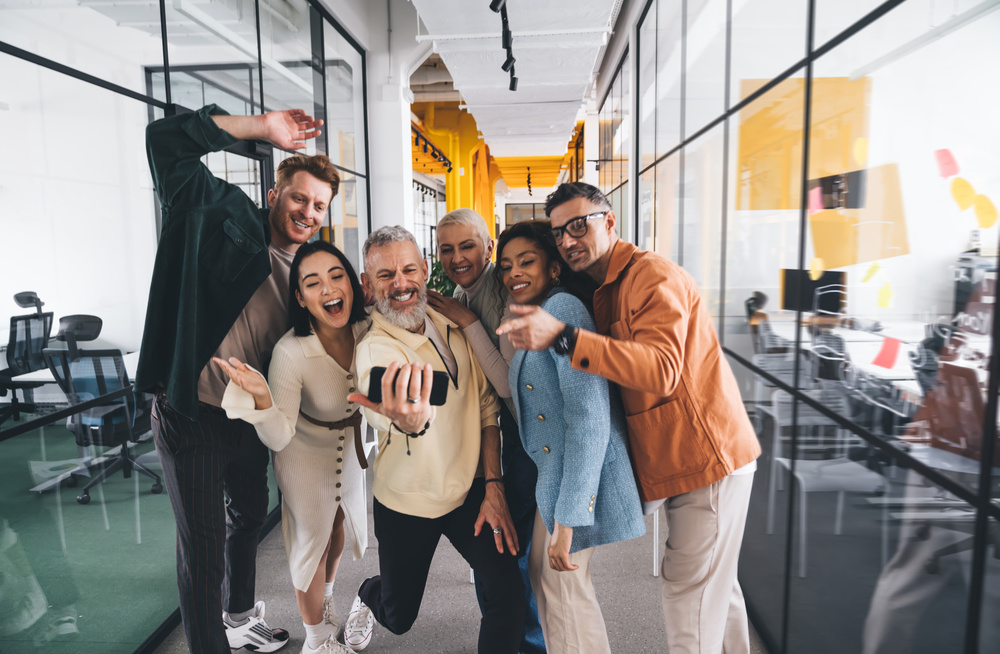
Navigating young people’s mental health; how to understand and support Gen Z in the workplace
In this Q&A with Mariyana Zhou, HR Director at fintech firm 1inch Network, who is speaking about AI at The Watercooler, revealed her struggle in trying to deliver a genuinely flexible and personalised wellbeing benefits package to her employees.
On the back of her comments and challenges, we reached out to leading benefits provider Gethin Nadin, Chief Innovations Officer, Benefex for his response, and his advice on how to get the best out of benefits, and how to make them more flexible and personal.
Don’t confuse choice with personalised support
This is a common mistake Nadin, with some employers falling into the trap of thinking that giving employees many choices is the same as giving them a personalised benefits experience. It isn’t.
As he says:
“To create personalised health and wellbeing experiences, we need to ensure that either employees can customise their experience themselves, or the employer facilitates this personalisation through data.”
True personalisation comes from using data to offer individual employees a benefits experience that is based on their specific preferences and needs. He likens this to the way consumers are already used to be served personalised choices by the likes of online streaming services or the way online book retailers serve up new suggestions:
“A library has a choice of books, but an online bookshop will use your spending history and book ratings to personalise your experience. We (benefits providers) should now be able to surface a benefits experience that is bespoke – so employees are suggested the benefits they may be interested in and shown how certain benefits can help them and their lives.”
Technology should save employers hundreds of hours in terms of admin time
According to Nadin, the average employer spends around 20-25% of the cost of their payroll on benefits, making benefits a huge expense.
“This expense should be managed carefully to get the most out of that investment,” he says, adding the technology is available to save clients a huge amount of time in admin and can “be very effective at delivering high quality, highly engaged benefits schemes”.
Moreover, a good benefits provider, he says, will not push a product on you but will help you to design and build a scheme with as little impact on your and your team as you need.
“Many benefit technologies now offer varying levels of self service, so the employer can flex up and down how much they get involved based on resource their end or appetite to get involved,” he says.
A mindset change towards benefits is necessary if they are really to make the biggest impact
This is a point that Zhou made in her Q&A, and that Nadin agrees with adding that: “We also need more boards and CEOs to understand that benefits are no longer just about reward – they are about talent management, productivity, wellbeing, sustainability, etc.”
As he says, used intelligently, benefits don’t just attract people to an organisation, but they can also be used to attract and retain certain talent pools, and boost employee wellbeing and subsequently productivity.
“They are a core and growing part of an EVP and require us to invest more in them as a result,” he says.
Your benefits provider should be able to advise you on the best benefits to offer
As Nadin says, benefits providers via employers should have access to millions of data points which can give insight on what benefits and benchmarking should exist in a client’s scheme.
“A good provider will not only be able to surface that data to help you choose what benefits to roll out, but they’ll also show you levels of eligibility or entitlement and even predict cost savings – all based on a decade of real customer data. Combining real world data from other, similar employers as well as capturing employee preferences is a strong position to be,” he says.
Good data is key
“You should have benefit specific employee surveys as well as post-enrolment satisfaction surveys. It’s also good practice to get a working group of random employees who can give you qualitative data, not just quantitative,” advises Nadin.
Don’t just consider what your employees want, consider what you want them to have
Again, Nadin makes this point that benefits can drive “better outcomes” for employers, not just employees. As an example, he encourages you to ask the question: what benefits will reduce turnover or lessen absence rates?
Make sure your provider enables you to choose benefits when needs arise
According to Nadin this is really importance and often known as “anytime benefits”. They are set up outside of enrolment periods so employees can still choose them.
Employers should shop around and, even when budgets are tight, approach some of the established players for deals
Nadin concedes that perhaps smaller employers don’t get as much choice or flexibility when it comes to benefits, and there are newer, smaller vendors which operate from fixed choice models with very little customisation. However, he also adds that “many enterprise providers are keen to work with fast growing, small employers too”.
“There are true flexible or online benefit providers, but these are few and far between. Most of the players are now fixed models where an employer chooses from a “set menu”, rather than having a scheme that is as individual and flexible as most employers are,” he says.
Finally…
Finally, in response to Zhou’s comments that smaller vendors tend to be more flexible, he says this doesn’t chime with his experience, in which he’s found the opposite. And, with regard to Zhou’s desire to find a package that will simplify and communicate all the benefits, according to Nadin, this does currently exist, as does “personalised content and communications based on the individual”.
No doubt this will be a hot topic of discussion at The Watercooler, which Zhou will potentially touch on in her session on ‘How to use AI to support wellbeing, HR and grow the employee value proposition’. Watch this space…
You might also like:

Benefits expert view: overcoming challenges to deliver personalised, flexible wellbeing benefits
Ian Macleod Distillers (IMD) embarked on a monumental journey to elevate their workspace, moving from their former office to the impressive Peter Russell House in Broxburn, West Lothian in an impressive new development. The new headquarters, with its architectural nod to distillery shafts, promised to accommodate IMD’s expanding portfolio of premium Scotch whisky, gin, and rum brands within its 10,000 square feet of dynamic office space. However, a challenge lay in not just creating a visually stunning workplace but also ensuring the well-being and productivity of their employees. Thus, began a collaboration that would introduce a breath of fresh air into their corporate environment.
Understanding the pivotal role of greenery in enhancing both aesthetics and atmosphere, Ian Macleod Distillers enlisted the expertise of Anchorpoint Interiors, renowned for their corporate and commercial workplace designs. Building on their successful past collaborations, Benholm Group was brought in to infuse greenery into the heart of the office renovation project.
The Solution: A Verdant Oasis Amidst Glass Towers
Benholm Group embarked on a mission to bring the outdoors in, utilising innovative green solutions to complement the architectural grandeur of the space. At the entrance, towering moss walls, reaching a height of 20 feet on either side of the reception area, immediately captivate visitors, setting the tone for a naturalistic journey within. These living walls, meticulously crafted with an assortment of moss types, create a stunning visual tableau against the backdrop of lofty ceilings. A scaled-down version of this green marvel adorns the break-out room upstairs, providing a tranquil retreat for employees.
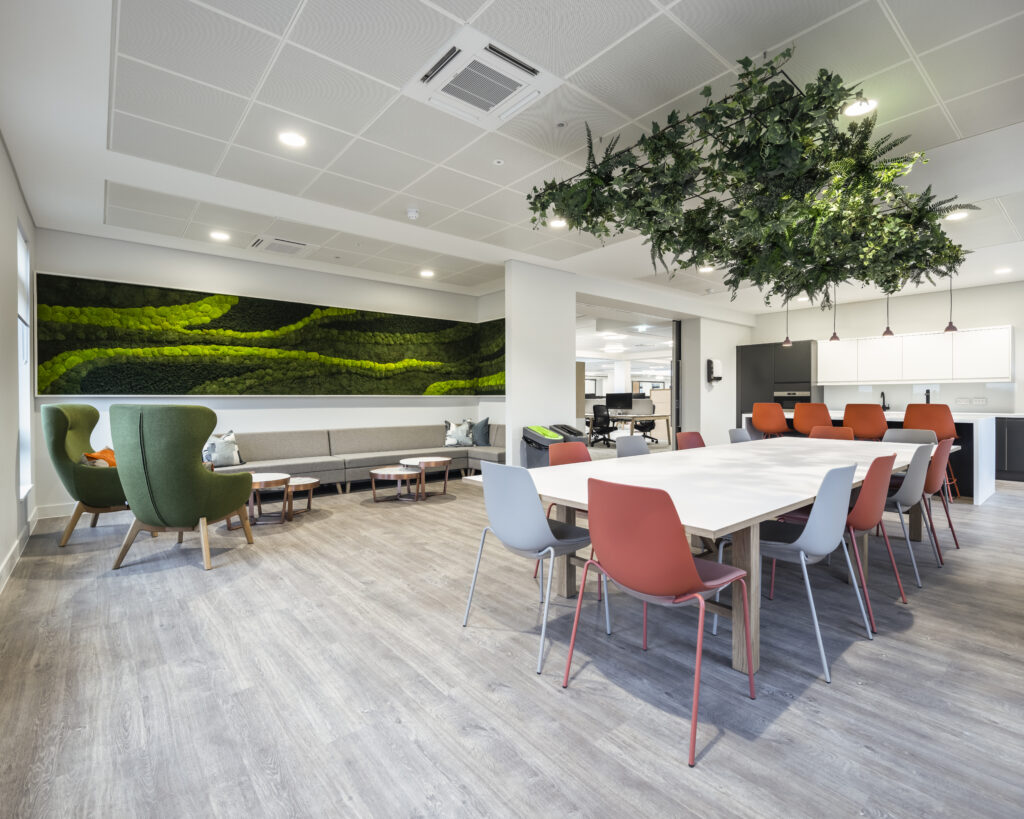
Central to the foyer stands a majestic 13-foot live Bucida Buceras tree, a living sculpture that not only adds to the aesthetic appeal but also imbues the space with a sense of serenity. Beneath the staircase, typically an underutilised space, Benholm Group ingeniously introduced a terrarium-like floor display, transforming it into a focal point of interest.
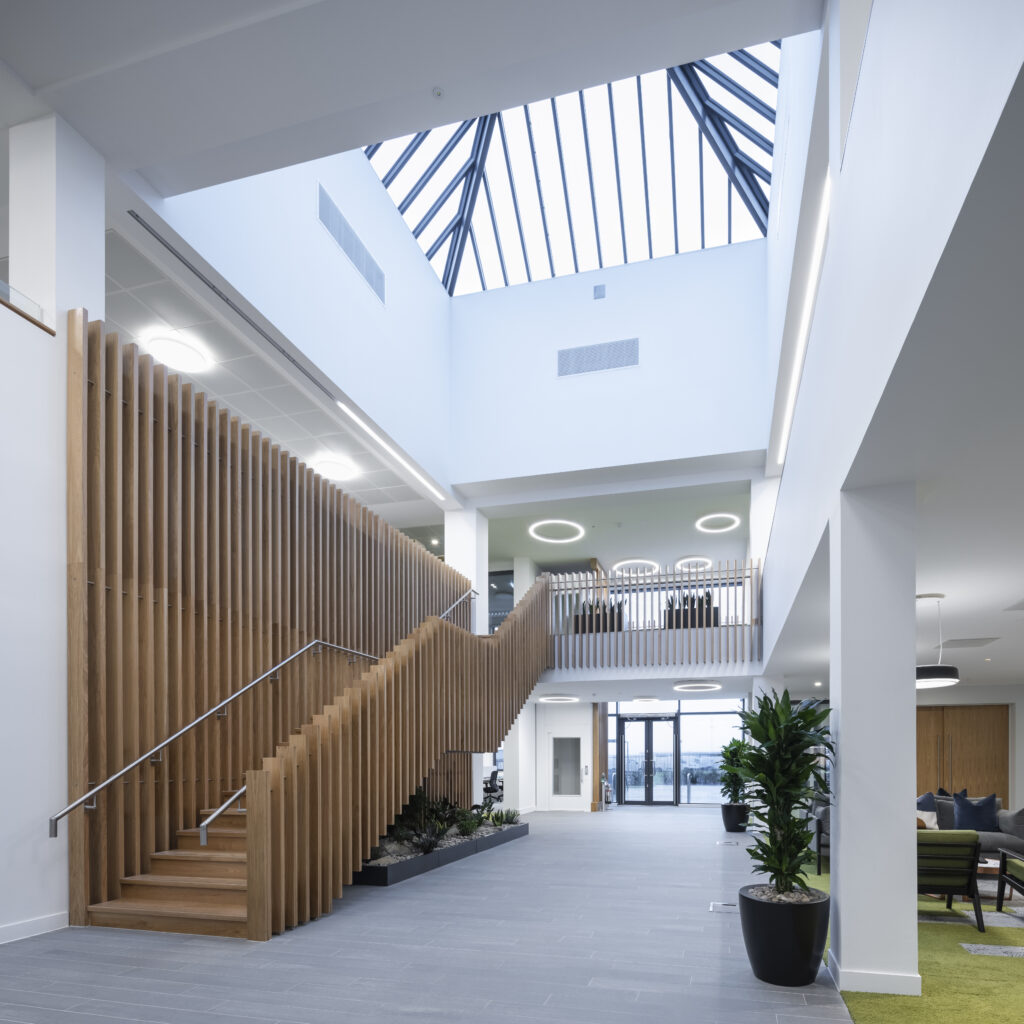
Artful arrangements of diverse planters, showcasing vibrant foliage in various styles and sizes, adorn both floors, strategically positioned to optimise visual impact. These green installations not only enhance the ambiance but also contribute to the overall well-being of occupants.

The Results: A Testament to the Transformative Power of Greenery
For Ian Macleod Distillers, the transition to their new headquarters marks a significant milestone in their journey of evolution and growth. With a legacy spanning over 80 years in the spirits industry, they understand the importance of embracing change to secure their future. Their new HQ, characterised by modern office spaces, gin development labs, and innovative design elements, positions them at the forefront of industry innovation.
Through collaboration with Anchorpoint Interiors and Benholm Group, Ian Macleod Distillers has succeeded in creating a workspace that seamlessly integrates nature with modernity. From the lush greenery that greets visitors to the meticulously curated plant installations, every aspect of the design reflects a commitment to fostering a vibrant and inspiring environment.

Brinsley Clarke, Sales & Precon Executive at Anchorpoint Interiors, acknowledges the pivotal role played by Benholm Group in bringing their design vision to fruition commenting “The flexibility, support, and expertise provided by Benholm Group have been instrumental in realising their concept design within a demanding project timeline”.
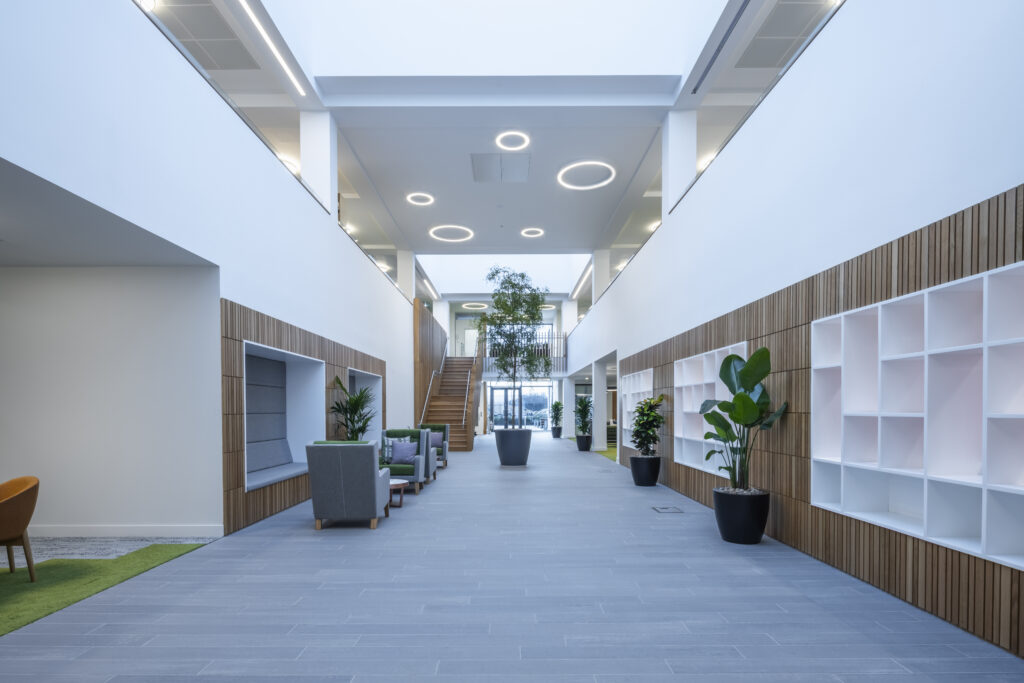
The transformative impact of greenery on interior spaces cannot be overstated. Beyond mere aesthetics, plants have the power to rejuvenate, inspire, and enhance well-being. As businesses strive to create environments that nurture creativity and productivity, incorporating green elements into the workspace emerges as a compelling solution.
Are you ready to transform your workplace into a verdant oasis? Contact Benholm Group today or visit us at The Office x Watercooler Event to explore how greenery can breathe new life into your office environment. Email mail@benholm.com or visit www.benholm.com
You might also like:
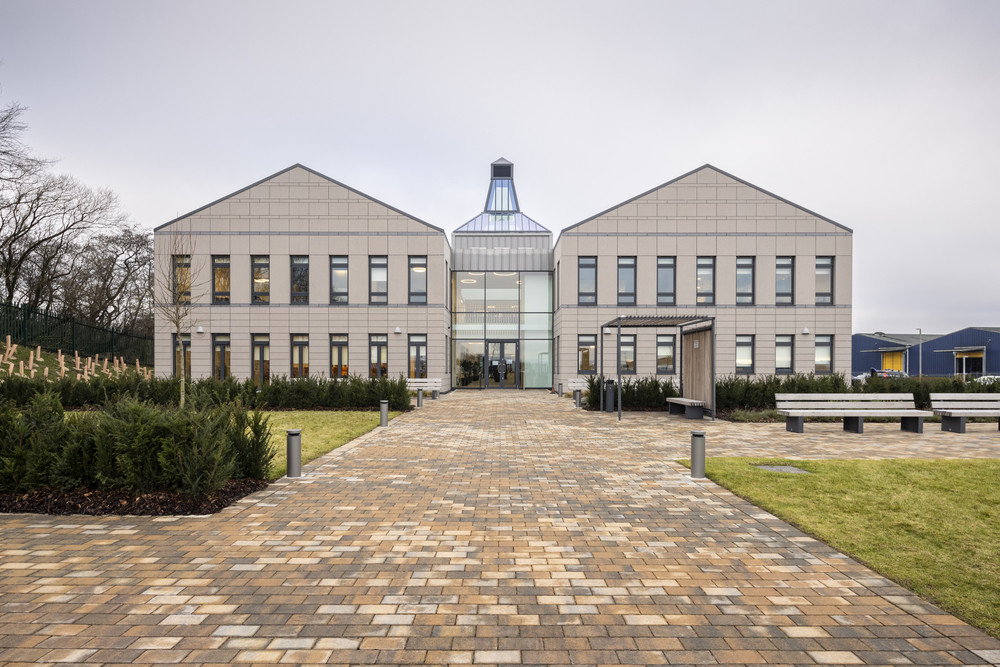
Benholm Group Infuse Ian Macleod Distillers with Greenery

Mariyana Zhou is Head of HR at fintech firm 1inch Network. She is always willing to share lessons learned – like this conversation we had with her about her struggles in delivering genuinely flexible, personalised benefits to her employees and her desire to offer them a ‘Chinese Menu’ style approach.
As you’ll see from the Q&A below, she hopes that AI will help her on this front – and, indeed, at The Watercooler, she will be speaking about ‘How to use AI to support wellbeing, HR and grow the employee value proposition’…
Tell me about your ‘Chinese Menu’ approach to benefits….
Of course! Well, instead of pushing out the same benefits to all employees, I advocate for a more personalised approach. I liken it to having a ‘Chinese Menu’ where people can pick and choose exactly what they want. It’s really personal and really putting the individual at the centre and giving them what is of true value to them, rather than just presenting them with a set menu of limited options to pick from. Basically, it’s the opposite of what I call ‘benefit washing’.
How difficult or easy has it been to attain your vision of putting the employee at the centre and creating that really personalised benefits experience?
It’s been extremely difficult. I believe that’s because it requires a mindshift change from organisations and professionals and the benefits administrators.
Also it’s difficult because benefits departments are traditionally under staffed and under funded, so the reality of the situation is that everyone is always looking for the quick win.
Can you tell me a bit about your experiences so far in trying to implement a highly personalised benefits package? Why has it been so difficult?
It’s really down to this mindset and organisational change which has to come from the board of directors and the executive level.
For me, we need to go from saying ‘hey, instead of buying all these benefits that may or may not be valuable to people, let’s put the employee first and find out what is valuable to individuals’.
What I’ve found is when you put the employee at the centre of the conversation, then you start asking different questions about benefits. For instance, you ask the employees directly ‘what is important to you? What do you want to be offered to help with your work life balance?’
You get very different answers coming forward from this approach. You find out more about your workforce and what is value add for them at this stage of their life. For example, it should come as no surprise to anyone that we have an aging population and elderly care responsibilities are on the rise, how are you helping the employees who are careers?
Have you been asking employees these questions then?
Yes, I have been doing this for a couple of years now.
Tell me more about the different answers you get from employees about benefits for wellbeing?
The most interesting thing is that we’ve found there’s sometimes a disconnect between what people think they want, and what they actually end up needing.
Our staff surveys said that people wanted the really fun benefits, like free yoga classes. But what we actually found is what they actually need, and valued most, were the benefits that really came good in hard times.
For example, we’d have people saying to us ‘my mum is ill, do I have medical cover for her?’ And, in that panic time, what they really value is being able to find that information really quickly and access the benefit easily.
Overall, what we’ve found is employees need some really core benefits so that when the worst happens, they have one-to-one support.
How flexible have you found the vendor market to be in helping you realise your dream of the ‘Chinese Menu’ approach to benefits?
Not flexible. I’m finding vendors work backwards rather than with the client in mind. Typically they’ll say ‘we have created this great benefit, which does this and this’ but I don’t need the whole product.
The trouble is, I’m usually talking to Business Development and Sales Departments, so they have targets linked to the product they have, so they inevitably work backwards and want me to buy the whole product, rather than cherry picking the bits I actually want.
But, as an employer, you can’t avoid not having a vendor because you can’t build your own benefits.
It sounds like a lot more work for you as a client to deliver personalised benefits, is that right?
Yes, huge amounts of work.
Have you got any good experiences of working with vendors to produce personalised benefits?
Yes. When we were launching our new pension offering in the UK what we found, through speaking to our people, was that they didn’t necessarily want pensions at all.
I should add the caveat here that this is our workforce demographic and I believe this could be very different for other organisations. What our employees really wanted was financial advice because there’s this huge stigma around financial wellbeing and no one talks about it. (There are a lot of people struggling with rent, bills or with big amounts of personal debt.)
I ended up talking to a large financial services company and negotiating a completely unique product, which included a one-to-one session with individuals to help them organise their savings plan for the future. That could include a pension (as well as information on ISAs, etc.), but the important thing is it’s completely independent advice personalised to them and not linked to the company or any particular products.
This benefit has been so successful that we even get employees asking us questions like ‘can I give this benefit to my brother or my friend?’
Have you found any differences between the large vendors and the smaller vendors of benefits packages?
Smaller ones are usually more willing to accommodate personalisation. They seem happier to say they could change details, or give us more options. They’re better with pricing as well as they have more flexible models.
Apart from personalising benefits, are there any other big challenges you are facing when it comes to benefits?
The biggest question that I’m currently trying to solve and don’t know how is ‘how do we communicate what benefits are available to employees for their particular situation?’
What I want is something that can simplify all the benefits, the policies and the terms and conditions so a person can easily access what they need quickly, when they need it, in a human language. I’m imagining (hoping!) the answer may come in a AI type of chatbot, but as far as I know, it doesn’t exist yet.
So, going back to the point about accessing benefits in tough times, that would mean someone could go into the benefits system and say ‘my mum has just passed away, how can you help?’ And then the chat bot would instantly tell the individual about their bereavement leave and counselling service, complete with all relevant telephone numbers, and any other benefits. (Pulling in relevant information from different policies and vendors.)
Basically, I’d love a system where employees just input their need and the system automatically feeds information back to them, going through the whole ‘Chinese Menu’ instantly and in a personalised way for that individual’s situation so they know how to access the benefit.
And in all your research you’ve not come across anything like that yet?
No. I’m hoping the US market will come up with a solution first! I’m keeping my eyes on them…
You may also like:
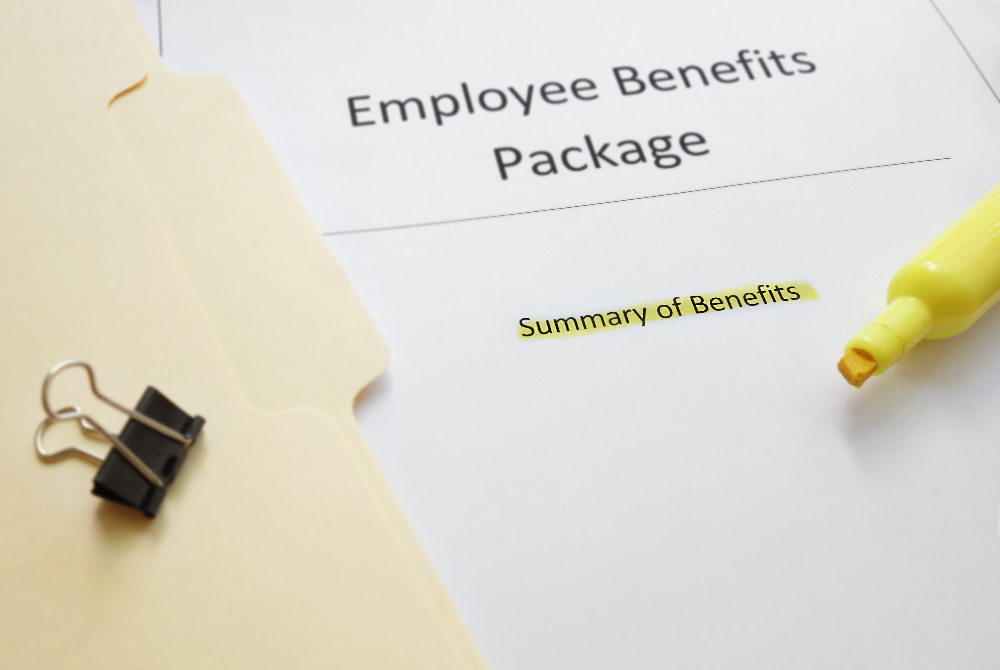
Employer view: the challenge of delivering personalised, flexible wellbeing benefits…
As we progress further into the 21st century, the workplace landscape is undergoing a transformative shift, predominantly influenced by Generation Z’s integration into the workforce. This generation, making up 30% of the workforce by 2023, brings with it distinct values—digital fluency, ethical commitment, and a strong desire for meaningful work. These traits are not just reshaping work environments but redefining corporate cultures across the board.
Gen Z’s entry into the market comes with heightened expectations. They seek authenticity, demand flexibility, insist on ethical practices, and prefer roles that yield genuine social returns. This new paradigm presents complex challenges for contemporary leaders, who must now rethink traditional business models and workplace strategies to accommodate a generation that is as questioning as it is innovative.
Yet, within these challenges lies great opportunity. Organisations that effectively engage Gen Z can unlock a reservoir of innovation, productivity, and sustainable growth. Successfully adapting to their needs doesn’t just enhance workforce dynamics—it can significantly elevate a company’s competitive edge in attracting and retaining young talent.
This article focuses on five revolutionary principles pivotal for organisations aiming to leverage Gen Z’s unique traits. By adopting these strategies, companies can transform potential generational friction into thriving synergies, creating workplaces that not only align with Gen Z’s expectations but are propelled by them.
1. Trust – The Bedrock of Gen Z Engagement
For Gen Z, trust goes beyond traditional ideals—it’s the bedrock of their workplace engagement and commitment. Born into an era marked by digital transparency and a deluge of information, this generation demands a work culture that champions trust and honours their need for autonomy. Eschewing outdated command-and-control management styles, Gen Z flourishes in settings that respect their freedom to shape their work processes and outcomes.
Empowering Gen Z starts with adopting a trust-first approach, offering them the space to own their work. When these young professionals feel trusted, they are more inclined to take initiative, think innovatively, and invest deeply in their roles.
Moreover, a commitment to trust necessitates a re-evaluation of goal-setting and feedback mechanisms, fostering an atmosphere where open communication thrives and Gen Z workers feel secure in voicing ideas, learn from mistakes, and grow without fear of undue criticism.
Thus, trust is not just a functional aspect of work culture for Gen Z; it is the essential foundation that activates their potential and propels long-term organisational success.
2. Cultivating Clarity and Connection
Transparency is vital for engaging with Gen Z, a demographic that places a premium on clarity and authenticity. This commitment to transparency must permeate all levels of an organisation, ensuring that everyone from the C-suite to interns understands not only what decisions are made but also why they are made.
For Gen Z, transparency means being integrally connected to the fabric of the company. When decisions are made openly and corporate values are visibly enacted, it nurtures deeper trust and loyalty among these employees. They seek a resonance between their personal values and their professional environments, and when they perceive this alignment, their engagement with the company intensifies.
A transparent workplace cultivates an atmosphere where feedback is not only welcomed but acted upon, where successes and setbacks are openly discussed, and where every individual feels they have a stake in the company’s ambitions. This level of openness significantly boosts engagement, as Gen Z employees feel genuinely respected and valued as integral partners in the organisation’s journey.
3. Shaping Workspaces for Tomorrow
Adaptability is crucial when designing workspaces for Gen Z who flourish in environments that reflect their dynamic work styles and values. The concept of future-proofing workspaces involves creating versatile areas that can adapt to evolving work patterns and demographic shifts within the workforce.
The key to effective workspace design lies in embracing flexibility and dynamic environments that can accommodate a range of activities, from collaborative brainstorming to focused individual tasks. Such spaces should be engineered to transform effortlessly, accommodating not only the current array of work demands but also anticipating future changes in work processes and team dynamics.
For Gen Z, a workspace that prioritises adaptability demonstrates a deep understanding of their varied needs and preferences. This recognition significantly enhances their engagement and job satisfaction, providing them with the environments and tools that resonate with their preferred ways of working.
Incorporating a design philosophy that focuses on personalisation ensures that each environment becomes a potent catalyst for innovation and efficiency. Such future-proof, adaptable spaces are designed not just for the present but with the foresight to evolve over the next 2, 3, 5, and even 10 years, as Gen Z’s presence in the workforce grows.
4. Harnessing Gen Z’s Innovative Potential
For Gen Z, innovation means much more than thinking outside the box. Renowned for their tech fluency and drive to challenge norms, Gen Z can be a powerhouse of revolutionary ideas, reshaping industries when empowered by conducive environments.
To tap into the transformative potential of Gen Z, workspaces must be crafted to encourage both the spontaneous interactions and the focused solitude that catalyse groundbreaking ideas. Collaborative areas, equipped with cutting-edge technology and designed for flexibility, are crucial. These spaces enable teams to effortlessly gather, exchange ideas, and push the boundaries of traditional thought processes.
Innovation, however, doesn’t solely thrive in group settings. Quiet zones for deep reflection and individual brainstorming are equally vital. Acknowledging that the creative process oscillates between dynamic collaboration and quiet reflection, providing a spectrum of work environments ensures all employees can find their ideal setting for different activities.
Fostering a culture where innovation is ingrained in daily activities demands a fundamental cultural transformation. By supporting varied work styles and cultivating an atmosphere that values both teamwork and personal insight, organisations can unlock the highest potential of Gen Z talent.
5. Social Responsibility and Ethical Practices
Gen Z expects their employment to reflect deeply held values, particularly concerning social responsibility and ethical practices. This generation’s commitment extends beyond awareness to active participation in social justice and community engagement, drawing them to companies that share these priorities.
Companies that authentically commit to sustainability and ethical operations resonate deeply with Gen Z. It is crucial for these young professionals that their employers actively advocate for societal betterment.
Transparency about the impact of their work on the community and the environment is also critically important to Gen Z. Companies that demonstrate real-world impacts are far more likely to cultivate deep engagement among Gen Z employees.
Embracing the Future with Gen Z
By aligning workplace practices with the aspirations of Gen Z, businesses are setting themselves apart in a competitive landscape. They are creating environments where young professionals feel deeply engaged, driving them to deliver exceptional performance and innovation. These companies are laying the groundwork for a workplace that is not only productive today but resilient and forward-thinking, ready to meet the challenges of tomorrow.
For organisations looking to not only survive but thrive, the message is clear: integrate these principles deeply and holistically into your workplace culture. The rewards—sustained innovation, robust employee engagement, and a leading edge in talent attraction—will define success in the decades to come. Let the journey toward a future shaped by vision, values, and vitality begin now.
Author’s Profile
Matt Elton, Co-founder of Future of the Office, has spent over 25 years steering companies to industry leadership. Today he pioneers the future of work. At the heart of his work is the ethos that the workplace should be an ecosystem where innovation and well-being are not mere concepts but lived experiences ignited by trust and transformation. With a passion for creating environments that resonate deeply with modern workforce needs, especially Gen Z, Matt champions a revolutionary approach to workspaces that are dynamic, inclusive, and sustainable. Discover more about his vision for transforming workplaces at Future of the Office.
You might also like:

Activating Gen Z’s Potential in the Workplace
The evolving nature of the workplace, and a heightened focus on employee wellbeing, demands new approaches that prioritise wellbeing and comfort, in addition to satisfaction and productivity. The emphasis at the office now lies in creating flexible and comfortable environments.
There is a rising demand for enhanced employee experiences through more considered workspace design. The recognition that employees engage in diverse tasks daily, advocates for varied workspaces to accommodate different activities, emphasising the importance of adaptable office architecture for the future of work. It is now acknowledged that individuals work differently, with preferences for varying levels of privacy and collaboration.
According to the Gensler Workplace Survey (2023), over 80% of office workers with a positive workplace experience can freely choose their workspace. Diverse spaces significantly enhance workplace effectiveness. In the UK, areas promoting rest, quiet individual work, and creative group activities have the greatest impact.
To meet the diverse needs of office workers, Mute—a pioneer of innovative office solutions, has launched OmniRoom in 2023, a game-changing modular room-in-room system for shaping flexible, construction-free, future-ready offices. This multi-award-winning modular office system, represented by obo in the UK, provides adaptable, construction-free workspaces that supports the following key principles:
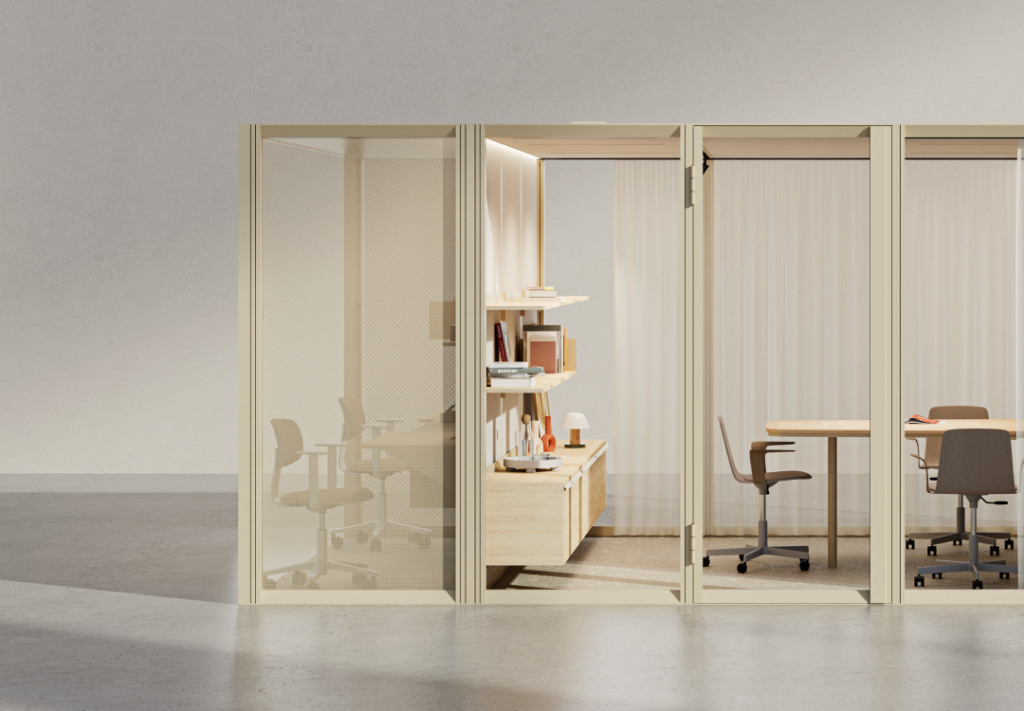
“Fit the Task”
In the contemporary workplace, more than a one-size-fits-all approach is needed. The new additions to OmniRoom include multifunctional hubs serving various office functions. Employers can create diverse work environments tailored to different tasks, encompassing focused work, collaboration, brainstorming, and video calls. Adaptable workspaces that accommodate both tasks and personal work styles enhance employee success and wellbeing, offering support and control over a broader spectrum of work tasks.
Employee Empowerment
Optimal results require individuals to work in environments that suit them personally. Office design should prioritise personalisation, empowering employees to manage their workspaces. This allows them to choose where, when, and how they work based on tasks, preferences, and work demands. Employee empowerment is increasingly crucial for retention and productivity, fostering a sense of ownership, responsibility, and trust.
Wellbeing
In today’s work environment, balancing wellbeing is paramount. A Deloitte and Workplace Intelligence report from 2023 underscores the need for employers to prioritise employee wellbeing for talent retention and organisational success. The report reveals significant percentages—60% of employees, 64% of managers, and 75% of the C-suite—consider leaving for a job that better supports wellbeing. ABW encourages reimagining the office as a space where wellbeing and productivity coexist. Workspaces fostering physical and mental comfort contribute to the longevity and productivity of organisations.
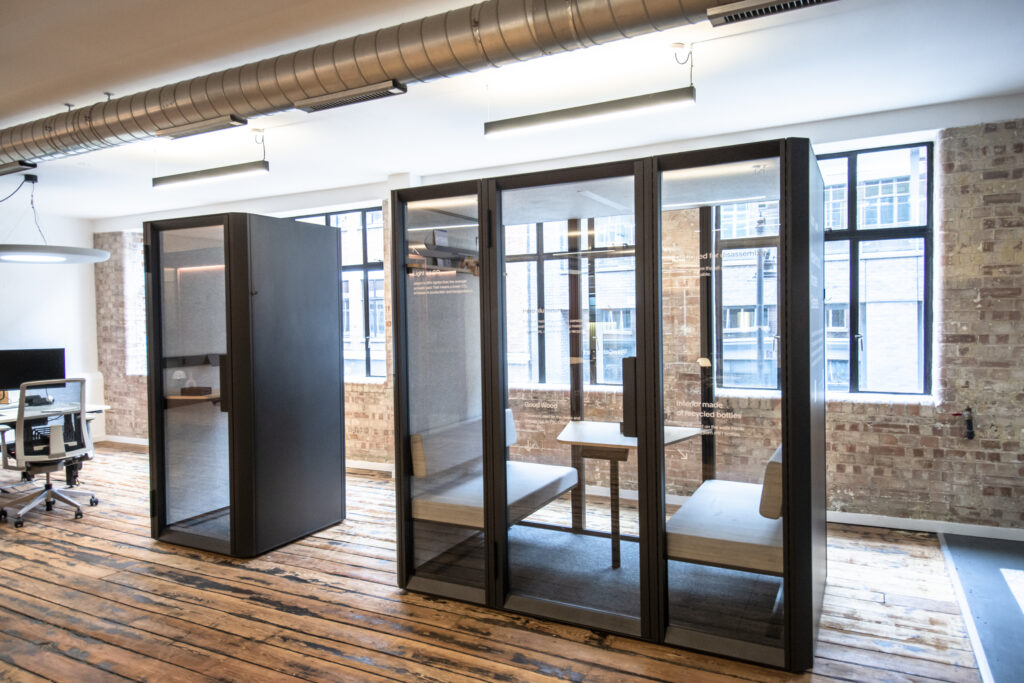
Creating quiet spaces in the modern office to enhance employee experiences
On the back of World Health Day (7th April), we’re continuing our focus this week on physical health and garnering more views on how this can be encouraged in the fast-evolving world of employee wellbeing.
There are many, sometimes opposing opinions emerging in this field and our job here at Make A Difference Media is to help employers find the right solutions for their employees and embed a holistic, inclusive, preventative approach right across their organisation.
With this in mind, it was good to speak with Dr Julia Jones, who was a sport and exercise scientist who moved into sports psychology, then neuroscience, working with the NHS and Team GB, for her potentially controversial perspective on this issue. She isn’t afraid to challenge the status quo, or even change her own mind about what strategies work best – which is exactly what she’s done in recent years as she’s learnt more about physical health and the most effective ways to effect meaningful change.
As always with employee wellbeing, there is never one size that fits all – could Dr Julia’s simplified approach to physical health work for your organisation?
We asked her for thoughts on the best way that employers can get their employees physically healthy…
This is what she said:
“For decades I was telling people to join the gym and do fitness protocols but, following my
extensive research, I’ve become fascinated by the fact that as the diet and fitness sector has
grown over the last 50 years, so has the scale of the health crisis. Everything we’ve been
telling people to do for decades hasn’t worked. But we’re still telling them the same thing!
My 5-year research project identified that all approaches requiring ongoing effort and/or cost
simply cannot be sustained for a lifetime by most people. These routines don’t align with our
evolutionary biology.
Corporate gym memberships fall into this trap – people dip in and out of them because they require effort which is unsustainable.
Especially when you consider that many people in the workplace are already feeling overwhelmed and in a perpetual state of busyness.
So what should we be telling them?
We need to find ways that are low effort, low cost and very highly aligned with our
evolutionary biology.
I’ve distilled these down to a few simple ‘habit hacks’ that emerged from my research as
most sustainable. These are now the only things I teach.
Habit Hacks:
Movement
Firstly, the type of movement you do in the gym doesn’t align with our evolutionary biology so requires effort to maintain. Our brain’s reward circuits go back to our caveman days when we would move to go and find food, or other humans so we could reproduce. Movement just happened through those survival activities. It was a byproduct of those other things we were doing.
So, for me, that’s how I live; movement is a byproduct of what I’m doing. I cancelled my gym membership, and I’ll never join another. You just need to stand up frequently throughout your day and get a few thousand steps in and you’ll significantly improve your health.
I’ll do a walk at lunchtime along the beach where I live, which is much better than rushing in the car to the gym in between Zoom calls. I added a hill walk into the route and I have a couple of dumbbells by my bed which I pick up as I get up.
There’s so much being talked about how you have to do high intensity workouts and other fitness fads. On paper the science stacks ups, but they can’t be susmaintained, so they don’t work in the long term.
It’s actually the small low-effort, free things, and embracing everyday movement like walking meetings or taking the stairs at work, that works much more effectively long-term. Many employees of my larger corporate clients often probably don’t even know where the stairs are.
The emphasis on fitness culture can create ‘exercise shaming’ for those that don’t like to use the gym.
Food
Another thing we’re doing that doesn’t match our evolutionary biology is we are eating across a much too long time period, sometimes 16-hours. We never had such frequent access to food in the past. I encourage people to reduce their eating window to eight to twelve hours.
So, that means an earlier dinner and/or later breakfast.
We’ve spent years brainwashing people that breakfast has to be consumed as soon as we wake, but it’s just not true! Many leading longevity scientists now are having just one meal a day so they regularly enter a fasted state to boost cellular health.
Breathing
Modern life chronically triggers our fight or fight response. We need to slow down our breath and retrain our autonomic nervous system to be predominantly in parasympathetic mode. That means breathing at six breaths per minute and extending your exhales to maximum benefit.
I’ve recently designed Music Hack tracks with Universal Production Music to help people practice that rhythm of pace. I was first taught this technique during a visit to a US Navy SEALs base in the early 1990s and yet it’s still not yet common practice in the workplace.
Early Daylight
Get early daylight exposure in the morning to give the Circadian neurons the blue light signal they need to regulate quality sleep.
It took a long time for me to admit that as a profession we’d got it wrong for so many decades. But now we know why everything to date has failed and it’s time to turn attention to helping employees making the low-effort, free, tweaks to a handful of habits that can quickly benefit their wellness pillars and have the potential to improve their future health outcome too.”
For more info on Julia’s work visit www.holidity.com
She will also be speaking at The Watercooler on ‘The new normal – the secret to lasting habit change’, along with TV Presenter and Journalist Steph McGovern. You can find out more and register here.
You might also like:
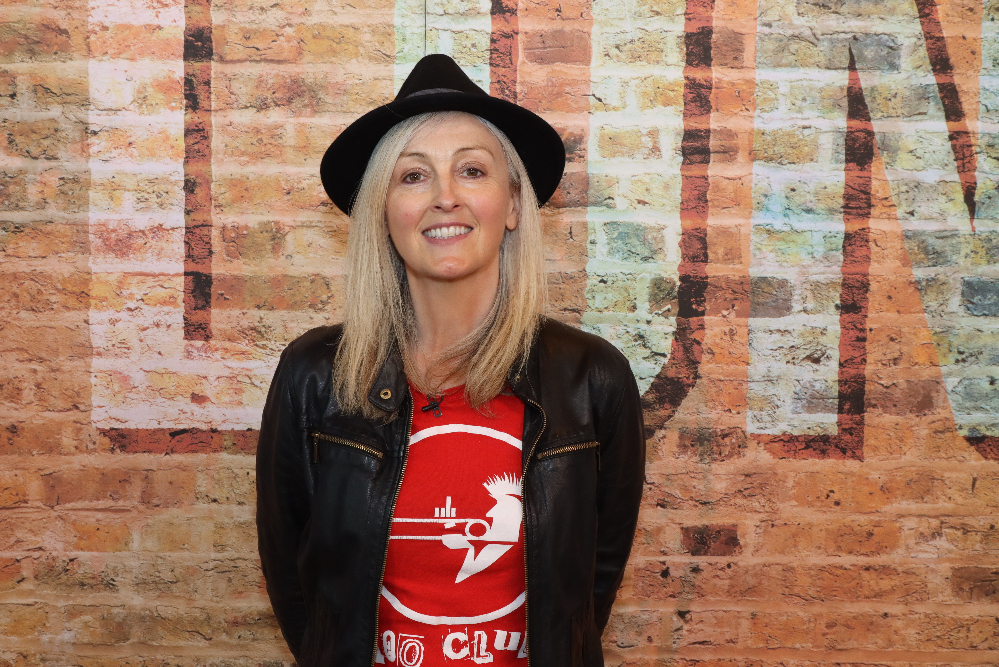
If you’re telling your employees to join the gym, could you be giving them bad advice?
This year’s Mental Health Awareness week takes place between 13th and 19th May and the theme is Movement and Mental Health. This theme may surprise many who perhaps do not equate movement with supporting their mental wellbeing but in fact regular movement is fundamental for good mental health and is something we should all be thinking about.
Humans evolved to move, and as well as the more commonly known physical-health benefits of exercise, regular movement offers many boons for our mental health. It can help lower feelings of anxiety and depression, reduce negative moods and thinking patterns whilst boosting confidence, self-esteem and improving sleep quality.
In my work as a mental health teacher, speaker and presenter, I have become aware of the legacy of the pandemic that has left many people living increasingly sedentary lifestyles, lamenting that they move less, get outside less frequently and do not exercise as much as they used to. The pandemic forced on us lives that were home-based, screen-focused and that restricted our ability to stay active and hybrid working has cemented this lifestyle.
We all now navigate a new-normal that generally means we engage in less movement. Gone is the walking to the station of the regular commute, the nipping out to the coffee shop, the walks at lunch and going to the gym after work and these movement-based activities are not being replaced. Research shows that around 34 per cent of men and 42 per cent of women do not engage in enough activity for good mental health1 and Public Health England have said that we are 20% less active than we were in the 1960s, a percentage they expect to rise to 35% by 20302.
With the unprecedented demand on NHS mental health provision, there has never been more of an urgent need to get back to previous habits, to get up and move more to support our mental wellbeing. And remember, movement does not simply mean exercise (although regular exercise is important!), it includes all those small moments of stretching reaching, walking and dancing that are part of an active life. Here are some ways that you can begin to improve your level of movement and exercise:
Stretch More
A great way to bring more movement into your day and to reap some much needed benefits is to take a few minutes every hour to get up from your desk and stretch. This simple act gives you a break from screen time, increases serotonin levels, helping stabilise mood and reduce stress, helps break up the stress hormones stored in our muscles and relieves tension and headaches. A few minutes every hour soon builds up!
Choose to Move
I know it sounds obvious, but one way to up our movement levels in daily life is to, well, do more movement. Look for ways you could be more active where you might otherwise choose a more sedentary option. Make going for a walk part of your day, perhaps during a lunch break or other times when you might otherwise drive, such as the school run or popping to the shops. Take the stairs instead of the lift, engage in activities like gardening or doing YouTube yoga stretches and why not take 5 minutes on your own to dance to your favourite tunes, boosting movement and dopamine!
Exercise
Although regular informal movement is essential, the importance of regular exercise cannot be ignored. According to the NHS, adults should be looking to engage in 75-150 minutes of exercise a week, meaning any activity that raises your heart rate and makes you breathe faster! We all have differing levels of fitness, mobility and experience of exercise but there are activities and exercises out there to suit all needs. Start slowly and build and look to engage exercise that you can enjoy as this will help sustain you! Join a group or a club to help build momentum through shared experience. Look online for exercises that suit you and get involved. It can be tough at first but the benefits to your mental health soon become clear and you will thank yourself for having taken the first step.
Mindful Movement and Flow
Not all movement has to be about pace. Focusing on slow, deliberate movement through the practice of Mindfulness has been shown to improve attention, reduce stress, anxiety and symptoms of depression. Similar to yoga but with an emphasis on easily accessible and familiar movements, mindful movement helps us focus the mind and enter the “flow state”, reducing the mental chatter that can feed negative moods and mental health issues. Anyone can do mindful movement and its combination of unhurried moves and present moment focus is a winning combination that will help us manage and work through the stresses of the day.
You can find out more about how you can get involved with Mental Health Foundation’s Mental Health Awareness Week here.
1 https://www.harpersbazaar.com/uk/beauty/fitness-wellbeing/a42385380/movement-health/
You might also like:

Movement, Mental Health and You: Get moving for mental health awareness week
Physical activity can be used as a gateway into other pillars of wellbeing because there’s less of a stigma around physical health than, say, mental health or having issues with financial wellbeing. The recognition of the importance of physical wellbeing could be one reason that the Mental Health Foundation has chosen ‘movement’ as its theme for Mental Health Awareness Week this year, which takes place from 13-19th May.
Companies like Jaguar Land Rover have found physical health can be a good “entry point to introduce other services that people may feel stigma in coming forward to use”, says Dr Steve Illey, Chief Medical Officer, Jaguar Land Rover.
He says that it’s essential to recognise the interrelated nature of the pillars of wellbeing:
“We know that chronic physical disease can influence mental health and vice versa. We know that good physical health is protective for good mental health. We also know that good physical health supports good safety which is a bedrock of looking after people.”
BAM has also found physical health to be a great gateway to general wellbeing, recently launching ‘Get BAM Moving’ with the sole purpose of inspiring and engaging its employees to take ownership of physical health:
“This is to ultimately improve their physical and mental health and reduce our employees’ personal risk to the plethora of lifestyle related illnesses (stroke, cancer, diabetes, heart disease, dementia, etc),” says Ruth Pott, BAM UK & Ireland’s Head of Workplace Wellbeing.
As part of this, there’s a well established annual event – BAMathon, created by its HR Team, – run in the month of June, with all employees invited to make teams of up to 10 to run, walk, cycle or swim, which means the activity also taps into social wellbeing. “We have high levels of engagement with this event – 1 in 6 of our employees participated last year,” says Pott.
Given the fact physical health seems to increasingly be seen as a good ‘glue’ for other facets of wellbeing, we asked some employers who are active in this space to share their tips on getting this approach right…
Acknowledge there are health inequalities that might make keeping physically fit harder for some people than others
The Guinness Partnership has been doing some work around the menopause, as well as cancer, and for both of these physical conditions has been acknowledging intersectional differences.
“One of the key things we wanted to get across was that, not only are there health inequalities in the UK, but cancer affects different ethnic groups differently. We actually had a guest speaker from Bupa coming in during Black History Month to make this link and we talked about prevalence across different groups,” says Liz Skelton, Director of Health and Safety at The Guinness Partnership.
But be careful about how you make the link between different groups of people and health inequalities – rather than rely on anecdotal evidence, Skelton has found the best way to make these links is through robust data, like national statistics and published data. For instance,Cancer Research has published this research about ethnic disparities in cancer: First data in a decade highlights ethnic disparities in cancer – Cancer Research UK – Cancer News.
Volunteering can be a good way to link physical wellbeing with social wellbeing
Some employees will be put off by ‘traditional’ exercise, like the popular ‘couch to 5K’ or ‘fun runs’. This is where volunteering can be a really effective way to get people moving.
The Guinness Partnership, for example, has run volunteering days around activities like working in a food bank, which involves physical activity but isn’t labelled as ‘exercise’, which could alienate some employees.
“Things like company ‘fun runs’ are potentially not inclusive but volunteering activities can be more inclusive,” says Skelton.
Make any exercise groups as inclusive as possible
Further to her last point, The Guinness Partnership has also set up a Strava group to get people moving and there are hundreds of employees signed up.
However, key to its success has been the fact that the group description makes clear that you don’t have to a be a runner, or a cyclist, or a ‘serious’ sports person to be part of the group and it welcomes everyone. As a result, people are happy to post about walking for ten minutes, or doing a bit of stretching too.
“We have employees logging a little lunchtime walk, but also those cycling-crazy sportspeople who log 50 miles at the weekend,” says Skelton. “Everyone supports each other and the group has a really good vibe. I think what’s important is welcoming a spectrum of activities.”
Skelton adds, too, that often colleagues will meet up to do physical activities together and there’s a social element after.
“My advice would be, if you’re doing socials after physical activity to not focus them all around alcohol,” she says. “We’ve really tried to do different socials after team activities, like a pizza night instead of just going to the pub.”
Similarly, BAM is keen to make its physical activities as inclusive as possible and one way it’s done this is through its varied online digital programmes which include accessible fitness such as sitting yoga and those which vary in level and pace.
Signpost the Stairs
Sounds simple, but sometimes the simplest things work the best, advises Skelton. A gentle nudge from a poster by the photocopier, can be enough to remind people to get in their steps by taking the stairs rather than the lift.
Consider QR Codes & Health Machines
The Guinness Partnership is also just about to put QR code stickers on its desks to nudge people towards wellbeing content, the thinking being that, despite hot desking, they can still have easy access to this information.
It’s also introduced health machines where people can measure their blood pressure and BMI, hooking into ‘Know Your Numbers’ week to raise awareness of the importance of tracking physical stats.
“We’ve seen some real, tangible benefits from these like some of our people finding out they have high blood pressure and needing medication,” says Skelton. “What I would say is that you need to do quite a bit of publicity around these machines to generate the buzz to interest people.”
Add the fun factor
One of the biggest learnings that BAM’s Pott has gleaned so far is the importance of making physical activity events fun (and, just because you put ‘fun’ before ‘run’ does not necessarily make this the case for everyone!).
To do this, at its events BAM has previously included a photography competition and a Strava art competition. It’s also awarded a monetary donation to a charity of choice of the winning teams in its BAMathon (all employees are invited to make teams of up to 10 to run, walk, cycle or swim) which takes place across the month of June.
“The main challenge is getting those who do little or nothing to be involved and not feel intimidated by the competitiveness of others – the Team Captains are tasked with ensuring all in the team feel valued and part of the team, and that they enjoy it and hopefully feel fitter and better at the end of June,” she says.
After June, the next challenge is then encouraging employees to continue with their fitness and exercise goals. To this end, BAM has created its ‘Get BAM Moving’ programme which includes walking clubs and online/live/on demand fitness programmes.
You might also like:

